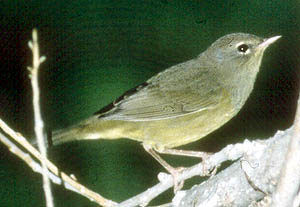An obvious Oporornis similar to MacGillivray's Warbler but with a yello wish wash to the throat and heavy black spotting along
the lower edge of the hood. It superficially resembled an Orange-crowned Warbler, but with sturdy pink legs, and
a larger, more rounded head, and thicker paler, blunter bill.
wish wash to the throat and heavy black spotting along
the lower edge of the hood. It superficially resembled an Orange-crowned Warbler, but with sturdy pink legs, and
a larger, more rounded head, and thicker paler, blunter bill.
The narrow eye-crescents were whitish, similar to MacGillivray's Warbler, but the lower crescent was longer resulting in a more complete eye-ring effect. The upper crescent wrapped more behind the eye, but stopped forward of the top of the eye.
The upperparts were uniformly olive with a yellow spot visible along the marginal coverts near the alula.
The underparts were bright yellow except for the lower border to the hood, which was the same dingy-olive color as the back. This was heavily stippled with black only along the lower border. The olive became paler toward the throat and blended with a pale yellow wash there. The sides and flanks were also washed with olive.
The yellow undertail coverts were very long and pointed, almost reaching the tip of the tail. The tail was olive above and gray below. It twitched its tail quite a bit similar to MacGillivray's Warbler. In my experience, Mourning Warblers usually have less active tail-movements than this bird.
The chip-note was heard several times. It was a hollow (almost two-parted) "tsick" with the quality of Bewick's Wren. It differed from the thicker more solid call-note of MacGillivray's, and sounded much like Mourning Warblers I have heard in the past.
 While birding the
area around the abandoned hotel at California City, Vernon and Andrew Howe arrived to tell Robbie Fischer and me
about a Mourning Warbler which had shown up at the 14th tee. We were not sure how to get to this spot, but Andrew
volunteered to go along with us and show us the way. Upon arrival a fair sized group was viewing the bird in a
clump of dead tamarisk at the edge of the golf course. Within a few minutes, this little skulker appeared and teased
us with views of the back and head. Finally we got great views of the underparts and I was able to take some detailed
notes.
While birding the
area around the abandoned hotel at California City, Vernon and Andrew Howe arrived to tell Robbie Fischer and me
about a Mourning Warbler which had shown up at the 14th tee. We were not sure how to get to this spot, but Andrew
volunteered to go along with us and show us the way. Upon arrival a fair sized group was viewing the bird in a
clump of dead tamarisk at the edge of the golf course. Within a few minutes, this little skulker appeared and teased
us with views of the back and head. Finally we got great views of the underparts and I was able to take some detailed
notes.
 Jon Dunn identified
this bird as an immature male. It is the only plumage which shows an apron of black spots along the lower border
of the hood. MacGillivray's has no such pattern. The yellow wash to the throat, the very long undertail coverts
and especially the call-note confirm the identification of this bird as Mourning Warbler. The face pattern was
equivocal, but probably within the range of both species.
Jon Dunn identified
this bird as an immature male. It is the only plumage which shows an apron of black spots along the lower border
of the hood. MacGillivray's has no such pattern. The yellow wash to the throat, the very long undertail coverts
and especially the call-note confirm the identification of this bird as Mourning Warbler. The face pattern was
equivocal, but probably within the range of both species.